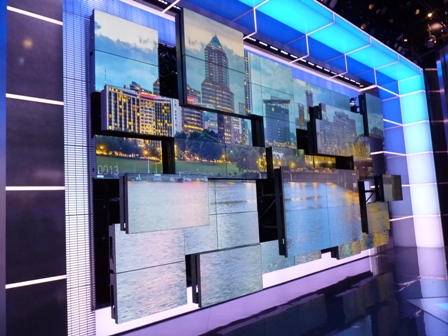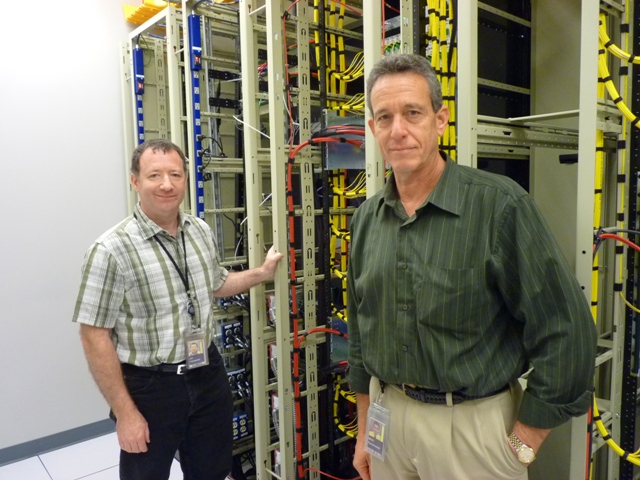BRISTOL, CONN.—After five years in development and construction, ESPN threw open the doors of its new Digital Center 2 to journalists recently, unveiling what the network believes to be the media production center of the future.

ESPN's new DC-2 facility occupies more than 194,000 feet and is across from DC-1 (left)
The new facility, located across from DC-1, which opened in 2004, has a footprint of more than 194,000 square feet with a fiber-based infrastructure that is format-agnostic and “future-proof,” in the words of ESPN execs. There are six new production control rooms, four audio control rooms and 16 edit suites.
“The group working on DC-2 was given a simple assignment,” said Jodi Markley, senior vice president of operations for ESPN. “Design and build technology that hadn’t been built yet, create studio environments with unlimited capabilities for content creation, make it a very comfortable place for our employees to work, and make it green. This facility far exceeds that original assignment. In fact, DC-2 is the most technically sophisticated media facility in the United States.”
The facility also represents a coming of age of sorts for ESPN’s signature program, “Sports Center.” The iconic sports program, which used to broadcast live at 6 p.m. and 11 p.m. daily, is now aired live 18 hours a day, growing into a franchise that requires massive amounts of content and production capabilities. Inside DC-2 are five studios with a combined space of 25,000 square feet.
“In comparison, we have nine studios on campus for a combined footprint of 29,000 square feet, so we’re almost doubling in size,” Markley said.

Studio X, the new home to ESPN's Sports Center
VISUAL HIGHLIGHTS
The new Sports Center studio, which goes live later in June, occupies almost 10,000 square feet and the NFL Studio, which will launch in September, is 9,000 square feet. Studio X, where Sports Center is located, is crammed with the latest in digital technology, including a total of 114 monitors, (compared to the current studio, which has 15). There’s two touchscreens, a floor video screen and two large vertical monitors, nicknamed the “Verts,” one of which can move forward and track along the floor while playing high-res video and graphics.
A multidimensional monitor wall features 56 individual monitors that play a variety of graphics and images. The monitors are all in different sizes, ranging in distance of 1 foot to three feet from each other and will provide a 3D-like graphics image for the viewer.
“Whatever content is on the monitor, it’s actually rooted in 3D space,” said Marina Escobar, senior director, creative technology atESPN. “It can move back, it can move forward, it can break the edges of the monitor. What this means to the home viewer is that if something is coming out of the monitor, meaning it’s at a different space, it can actually look like it’s coming at you. We don’t know exactly how we’re going to use it but we definitely know that it’s very different than anything we’ve done and no one else is doing it.”

Studio X features a wall with 56 LCD monitors that move back and forth, giving a 3D effect.
While the current Sports Center studio includes 13 cameras, there will be 40 cameras in DC-2. One such camera in Studio X is the JITA cam, also known as a “jib in the air.” Positioned on a first of its kind circular track 20 feet in diameter, the camera is attached to a nine foot arm that hands from the track. The camera can swoop as low as five feet from the ground and up to 22 feet in the air, providing a 360-degree view of the studio.
Graphics—especially the kind that illustrate statistics, always important in sports news and information—will be greatly improved in the new Sports Center set, with an emphasis on bolder colors and simpler presentation. “Graphics will be bolder, more colorful but with less information, said Craig Bengtson, vice president and director of news for ESPN, adding that the approach will make them easier to read.
“We’re using the displays on the set to give us information that we had previously put on the screen covering everybody up,” added Stephanie Gjorven, senior director of graphics and technology for ESPN. “So we’re able to keep our anchors on TV in a more immersive environment.”
To improve the graphics workflow, ESPN worked with Vizrt to develop the “Octoviz,” a device that improves graphics creation and expands its capabilities. The Octoviz has one output, and with eight Octovizes, this gives ESPN 56 channels of output.
strong>HEART OF THE FACILITY
A common theme throughout the facility is the goal of making it “future-proof” and with 4K on the horizon, ESPN’s routing facility is at the heart of achieving such a goal. Consider this: the network’s first broadcast center housed 600 tape machines, DC-1 brought that total down to 44 but nary a single tape machine is to be found in DC-2, bringing the new facility into an entirely file-based workflow.

Jon Pannaman, senior director of technology at ESPN (L) and Mitch Rymanowski, vice president of engineering
This file-based production scenario requires some hefty routing capabilities and the network, which is a long-time Evertz customer, deployed two Evertz EXE fiber-optic routers for the new facility. The EXE is a versatile platform with a 46 Tbps data plane, 6,320 Gbps control plane, and modular line card architecture. And while a typical baseband router can handle about a couple thousand signals at a time, ESPN’s new routing setup allows the network to handle up to 60,000 signals simultaneously over nearly 1,100 miles of fiber optic cable installed in the facility.
ESPN’s engineers are excited about moving from a mostly baseband routing scheme to fiber.
“If we just went baseband [in DC-2], we would need a 2,304-squared router, so we decided it was time [to go fiber], said Jon Pannaman, senior director of technology at ESPN. “If we wanted to do 1080p, and there’s a lot of talk about 4K, we just didn’t want to be tied to one signal bit rate.”
The Ethernet portion of the combined baseband/IP routing setup uses JPEG2000 compression, which was selected because of its minimal latency and the ability to scale.
“One EXE here will actually route the entire [Bristol] campus six times at 1080p and just under two times at 4K so that’s the kind of horsepower that’s there,” said Pannaman.
ESPN’s network has been upgraded to the point now that it has enough speed to download the entire text of the Library of Congress 169 times per day and the network processes 45 petabytes per day, twice the amount of Google’s daily workload. The original plan for DC-2 was to take in at least twice the number of feeds (than DC-1) to start and to go up to four times within the next year and go on from there, according to Kevin Stolworthy, senior vice president, content and information technology.
Environmental concerns were also on the minds of DC-2 designers and Markley noted that the building includes LED studio lighting that will save almost a million kilowatts a year, as well as a roof with a highly reflective membrane that could save enough power to power almost 3,000 homes and a rainwater capture system that takes rain and groundwater and uses it in the restrooms. Because of these modifications, ESPN has applied for LEED (Leadership in Energy and Environmental Design) certification according to Markley.
Much of the planning and new technology that went into DC-2 was based on close consultation with the network’s employees and ESPN President John Skipper highlighted the work of Chuck Pagano, the network’s CTO, who played a key role in designing the new facility. Pagano, who started with ESPN before it even began broadcasting in 1979, will be retiring in June.
“Chuck has been the foundation and the heart and soul of this company,” Skipper said. “There’s been no more important person in the history of cable television relative to how it looks, feels, is consumed now than Chuck. Everything that has happened technologically at this company, Chuck has been a part of.”
The professional video industry's #1 source for news, trends and product and tech information. Sign up below.
Tom has covered the broadcast technology market for the past 25 years, including three years handling member communications for the National Association of Broadcasters followed by a year as editor of Video Technology News and DTV Business executive newsletters for Phillips Publishing. In 1999 he launched digitalbroadcasting.com for internet B2B portal Verticalnet. He is also a charter member of the CTA's Academy of Digital TV Pioneers. Since 2001, he has been editor-in-chief of TV Tech (www.tvtech.com), the leading source of news and information on broadcast and related media technology and is a frequent contributor and moderator to the brand’s Tech Leadership events.

